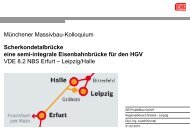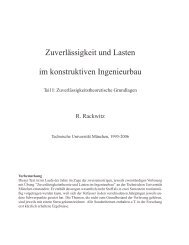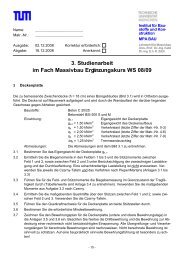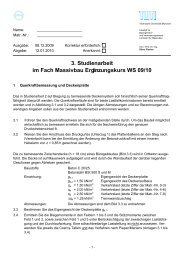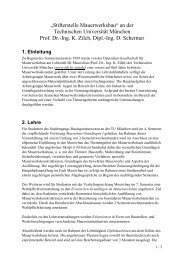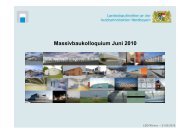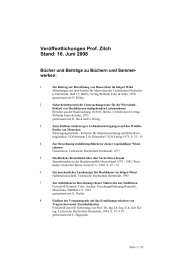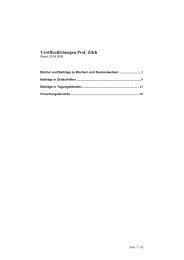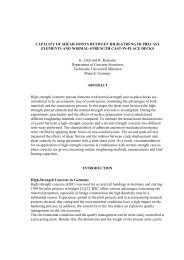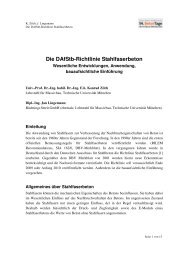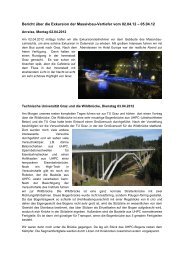Weiher and Zilch - Lehrstuhl für Massivbau
Weiher and Zilch - Lehrstuhl für Massivbau
Weiher and Zilch - Lehrstuhl für Massivbau
You also want an ePaper? Increase the reach of your titles
YUMPU automatically turns print PDFs into web optimized ePapers that Google loves.
<strong>Weiher</strong> <strong>and</strong> <strong>Zilch</strong> 2008 CBC<br />
Here it is commendable to use jacks for monostr<strong>and</strong>s. At abutments enough space for<br />
h<strong>and</strong>ling has to be kept free or the backfill has to be removed. Both are very complex <strong>and</strong> its<br />
application mainly for short-span pt bridges is not economical. At multispan bridges most<br />
tendons are anchored at the diaphragms <strong>and</strong> thus are easy to access.<br />
If restressing is done, one has to bear in mind that the additional stressing length is large<br />
enough so that the “new” imprints of the wedges into the steel are not at the same place than<br />
the “old” imprints. Therefore, depending on the stress increase, a certain minimum length of<br />
the tendon is required - otherwise the tendon has to be exchanged. An exchange also is<br />
required if the tendon is damaged (e.g. by fire or v<strong>and</strong>alism).<br />
PRODUCT QUALITY<br />
Unbonded tendons are often fabricated completely in a factory. Therefore, grouting on site<br />
can be avoided. The quality of works <strong>and</strong> the schedule is not influenced by weather<br />
conditions (e.g. frost). With unbonded tendons the installation <strong>and</strong> stressing of the tendons<br />
can be performed almost entirely independent from the reinforcing <strong>and</strong> pouring of the<br />
concrete. When using internal tendons the quick assembly can be assured by preparing few<br />
supports. Between these supports the tendon finds its final vertical position due to its<br />
stiffness (“free tendon curvature” 29 ).<br />
In Germany, the arrangement of tendons in the webs of boxes has been forbidden in 1999.<br />
For T-beams this is not valid. Compact shaped cross sections are advantageous because they<br />
weaken the cross section of the RC less. The fabrication of unbonded tendons off-site not<br />
only guarantees a high quality of the products but moreover accelerates the construction<br />
progress. The tendons can be shipped to the site briefly before it will be installed. With mass<br />
products (e.g. automobile industry) this Just-in-Sequence-concept (JIS) led to remarkable<br />
time <strong>and</strong> cost savings 30 . To prevent damages of the soft PE-ducts there are higher dem<strong>and</strong>s<br />
on the accuracy of installation <strong>and</strong> h<strong>and</strong>ling on-site. Deviation along sharp edges must be<br />
avoided which might lead to cutting of the steel through the polyethylene.<br />
INDICATION OF FAILURE<br />
Simple indication of tendon failures can be achieved by using unbonded tendons. They<br />
consist of prestressing steel, a wax-like corrosion protection mass <strong>and</strong> polyethylene<br />
sheathing. Fig. 5 (left) shows a two span girder with a bonded tendon (top) <strong>and</strong> a girder with<br />
an unbonded tendon (bottom), both with failed tendons close to the left support, e.g. due to<br />
stress corrosion. For the girder with the unbonded tendon, a local tendon failure is equivalent<br />
to a total failure along the total tendon length since there is no reintroduction of the force due<br />
to bonding. Therefore, the prestressing is also reduced in the areas of maximum bending<br />
moments (mid-support, mid-span) so that the girder will crack in these areas. Concrete<br />
cracking can be observed by many monitoring systems <strong>and</strong> can be verified numerically as an<br />
indication of tendon failure. The cracks are indicating the failure of the tendon; see Fig. 5<br />
(left). <strong>Zilch</strong>, Hennecke <strong>and</strong> Gläser have shown in their research, that cracking occurs far from<br />
the ultimate limit state of the structure 26 . In Fig. 5 (right) they illustrate their results in which<br />
a rather long part of a span will show cracks at rates of prestressing losses that do not harm<br />
6




